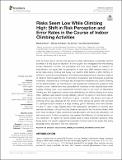Risks Seem Low While Climbing High: Shift in Risk Perception and Error Rates in the Course of Indoor Climbing Activities
Author(s)
Raue, Martina Julia; Kolodziej, Ronnie; Lermer, Eva; Streicher, Bernhard
DownloadPublished version (399.6Kb)
Terms of use
Metadata
Show full item recordAbstract
Little is known about people’s risk perception while participating in potentially harmful activities. In a field study conducted in a climbing gym, we investigated how the climbing activity influences climbers’ risk perception and error rates. Based on research on embodiment, we argue that the perception of risks may differ between being in an active state during climbing and being in an inactive state before or after climbing. In addition to subjective risk perception, error rates were observed as an objective measure of behavior that increase the risk for accidents. Experience was included as a potential moderator because indoor climbing is also accessible to inexperienced people. Drawing on the affect heuristic, we hypothesized that experienced climbers are guided by their intuitions, which makes them less susceptible for influences of their physical state when judging climbing risks. Less experienced climbers need to rely more on deliberative thinking and their judgments may be more distorted by the effects of being in an active state. Climbers were asked to judge climbing risks at five points in time (twice before, twice during and once after climbing in a gym). In addition, the amount and type of climbing errors was observed at two points in time during the activity. We recruited 57 participants (32% female) in a large climbing gym in Germany, who were between 18 and 57 years of age. Results show that participants’ perception of climbing risks generally decreased during the activity phase as opposed to the pre-activity phase, while error rates increased. Higher experience was associated with lower risk perception, but also more errors. Further, experience may weaken the influence of physical activity on risk perception. In higher risk sports people have to make important decisions while being active. Our results suggest that especially climbers need to be aware that being physically active can distort their risk perception. Keywords: risk perception; physical activity; climbing; mountaineering; embodiment; extreme sports
Date issued
2018-12-17Department
AgeLab (Massachusetts Institute of Technology)Publisher
Frontiers Media SA
Citation
Haue, Martina, et al. "Risks Seem Low While Climbing High: Shift in Risk Perception and Error Rates in the Course of Indoor Climbing Activities." Frontiers in Psychology, 9 (December 2018). © 2018 The Author(s)
Version: Final published version
ISSN
1664-1078